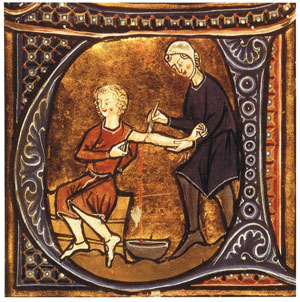History Of The Striped Barber Pole
 In the Middle Ages, barbers did more then just cutting hair. They also pulled teeth, performed minor surgery, and practiced bloodletting . French authorities drew a fine distinction between academic surgeons (surgeons of the long robe) and barber surgeons (surgeons of the short robe), but the latter were sufficiently accepted by the fourteenth century to have their own guild, and in 1505 they were admitted to the faculty of the University of Paris. As an indication of their medical importance, Harry Perelman points out that Ambroise Pare, "The father of modern surgery and the greatest surgeon of the Renaissance," began as a barber surgeon. The barber pole as a symbol of the profession is a legacy of the bloodletting. During bloodletting, patients squeezed a pole to allow their blood to flow better. The pole was often painted red to mask bloodstains. At the end of the operation the white bandages used would be hung on the pole and put outside the shop to air and advertise. Twirled by the wind, they would form a red and white spiral pattern that was later adopted for painted poles. The earliest poles were placed in the leech basin outside, which in time was transformed into a ball.
In the Middle Ages, barbers did more then just cutting hair. They also pulled teeth, performed minor surgery, and practiced bloodletting . French authorities drew a fine distinction between academic surgeons (surgeons of the long robe) and barber surgeons (surgeons of the short robe), but the latter were sufficiently accepted by the fourteenth century to have their own guild, and in 1505 they were admitted to the faculty of the University of Paris. As an indication of their medical importance, Harry Perelman points out that Ambroise Pare, "The father of modern surgery and the greatest surgeon of the Renaissance," began as a barber surgeon. The barber pole as a symbol of the profession is a legacy of the bloodletting. During bloodletting, patients squeezed a pole to allow their blood to flow better. The pole was often painted red to mask bloodstains. At the end of the operation the white bandages used would be hung on the pole and put outside the shop to air and advertise. Twirled by the wind, they would form a red and white spiral pattern that was later adopted for painted poles. The earliest poles were placed in the leech basin outside, which in time was transformed into a ball.

